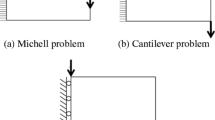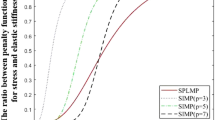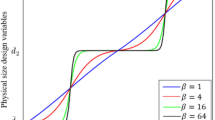Abstract
Optimal analytical Michell frame structures have been extensively used as benchmark examples in topology optimization, including truss, frame, homogenization, density and level-set based approaches. However, as we will point out, partly the interpretation of Michell’s structural continua as discrete frame structures is not accurate and partly, it turns out that limiting structural topology to frame-like structures is a rather severe design restriction and results in structures that are quite far from being stiffness optimal. The paper discusses the interpretation of Michell’s theory in the context of numerical topology optimization and compares various topology optimization results obtained with the frame restriction to cases with no design restrictions. For all examples considered, the true stiffness optimal structures are composed of sheets (2D) or closed-walled shell structures (3D) with variable thickness. For optimization problems with one load case, numerical results in two and three dimensions indicate that stiffness can be increased by up to 80 % when dropping the frame restriction. For simple loading situations, studies based on optimal microstructures reveal theoretical gains of +200 %. It is also demonstrated how too coarse design discretizations in 3D can result in unintended restrictions on the design freedom and achievable compliance.











Similar content being viewed by others
Notes
1 We note that the term “optimal”is grossly overused in the discussion of numerical topology optimization results in the literature, however, the variable thickness sheet problem is indeed a convex problem and hence convergence to global optima can in this case be guaranteed.
2 Note that the analytical Michell solution is pin-supported at the lower corners but this would cause stress singularities when modeled using a continuum formulation. We have found that reducing the line support to the lower three rightmost and leftmost elements, mimicking a pinned support does not change the conclusions of this study.
References
Aage N., Andreassen E., Lazarov B. (2015) Topology optimization using PETSc: An easy-to-use, fully parallel, open source topology optimization framework. Struct Multidiscip Optim 51(3):565– 572
Allaire G., Kohn R.V. (1993) Explicit bounds on the elastic energy of a two-phase composite in two space dimensions. Q Appl Math 51:675–699
Amir O., Aage N., Lazarov B. (2014) On multigrid-cg for efficient topology optimization. Struct Multidiscip Optim 49(5):815–829
Andreassen E., Andreasen C. (2014) How to determine composite material properties using numerical homogenization. Comput Mater Sci 83:488–495. doi:10.1016/j.commatsci.2013.09.006
Balay S., Abhyankar S., Adams M., Brown J., Brune P., Buschelman K., Dalcin L., Eijkhout V., Gropp W., Kaushik D., Knepley M., McInnes L., Rupp K., Smith B., Zampini S., Zhang H. (2015) PETSc users manual. Tech. Rep. ANL-95/11 - Revision 3.6, Argonne National Laboratory. http://www.mcs.anl.gov/petsc
Beghini L., Beghini A., Katz N., Baker W., Paulino G. (2014) Connecting architecture and engineering through structural topology optimization. Eng Struct 59:716–726. doi:10.1016/j.engstruct.2013.10.032
Bendsøe M.P. (1989) Optimal shape design as a material distribution problem. Structural Optimization 1:193–202
Bendsøe M.P., Haber R.B. (1993) The Michell layout problem as a low volume fraction limit of the perforated plate optimization problem: An asymptotic study. Struct Optim 6:263–267
Bendsøe M.P., Kikuchi N. (1988) Generating optimal topologies in structural design using a homogenization method. Comput Methods Appl Mech Eng 71(2):197–224
Bendsøe M.P., Sigmund O. (1998) Optimering af konstruktioners topologi, form og materiale. Udstillingen
Bendsøe M.P., Sigmund O. (2004) Topology Optimization - Theory Methods and Applications. Springer Verlag, Heidelberg
Chan A. (1960) The design of Michell optimum structures. Cranfield College of Aeronautics
Francfort G.A., Murat F. (1986) Homogenization and optimal bounds in linear elasticity. Arch Ration Mech Anal 94(4):307–334
Gibiansky L.V., Sigmund O. (2000) Multiphase elastic composites with extremal bulk modulus. J Mech Phys Solids 48(3):461–498
Grabovsky Y., Kohn R.V. (1995) Anisotropy of the Vigdergauz microstructure. J Appl Mech 62(4):1063–1065
Graczykowski C., Lewiński T. (2010) Michell cantilevers constructed within a half strip. tabulation of selected benchmark results. Struct Multidiscip Optim 42(6):869–877
Guedes J.M., Kikuchi N. (1990) Preprocessing and postprocessing for materials based on the homogenization method with adaptive finite element methods. Comput Methods Appl Mech Eng 83:143–198
Guest J., Prevost J., Belytschko T. (2004) Achieving minimum length scale in topology optimization using nodal design variables and projection functions. Int J Numer Methods Eng 61(2):238–254
Hashin Z. (1962) The elastic moduli of heterogeneous materials. ASME J Appl Mech 29:143–150
Hassani B., Hinton E. (1998) A review of homogenization and topology optimization I-homogenization theory for media with periodic structure. Compos Struct 69(6):707–717
Lurie K.A., Cherkaev A.V. (1984) G-closure of a set of anisotropically conducting media in the two-dimensional case. J Optim Theory Appl 42(2):283–304
Martinez P., Marti P., Querin O. (2007) Growth method for size, topology, and geometry optimization of truss structures. Struct Multidiscip Optim 33(1):13–26. doi:10.1007/s00158-006-0043-9
Michell A.G.M. (1904) The limit of economy of material in frame structures. Philos Mag 8(6):589–597
Milton G.W. (1986) Modelling the properties of composites by laminates. In: Ericksen JL, Kinderlehrer D, Kohn R, Lions JL (eds) Homogenization and Effective Moduli of Materials and Media, IMA, vol 1. Springer Verlag, pp 150–174
Nguyen T., Paulino G., Song J., Le C. (2012) Improving multiresolution topology optimization via multiple discretizations. Int J Numer Methods Eng 92(6):507–530
Norris A.N. (1985) A differential scheme for the effective moduli of composites. Mech Mater 4:1–16
Rossow M.P., Taylor J.E. (1973) A finite element method for the optimal design of variable thickness sheets. AIAA J 11:1566–1569
Rozvany G.I.N. (1998) Exact analytical solutions for some popular benchmark problems in topology optimization. Structural Optimization 15(1):42–46
Rozvany G.I.N., Ong T.G., Szeto W.T., Sandler R., Olhoff N., Bendsø MP (1987) Least-weight design of perforated elastic plates. I Int J Solids Struct 23(4):521–36
Sigmund O. (1999) On the optiMality of bone microstructure. In: Pedersen P, Bendsø MP (eds) Synthesis in Bio Solid Mechanics, IUTAM. Kluwer, pp 221–234
Sigmund O. (2000) A new class of extremal composites. J Mech Phys Solids 48(2):397–428
Sigmund O. (2001) A 99 line topology optimization code written in MATLAB. Struct Multidiscip Optim 21:120–127. doi:10.1007/s001580050176. MATLAB code available online at: www.topopt.dtu.dk
Sigmund O. (2007) Morphology-based black and white filters for topology optimization. Struct Multidiscip Optim 33(4-5):401–424
Sundström B. (2010) Handbook of solid mechanics. Department of Solid Mechanics, KTH
Vigdergauz S.B. (1989) Regular structures with extremal elastic properties. Mechanics of Solids 24:57–63
Vigdergauz S.B. (1994) Three-dimensional grained composites of extreme thermal properties. J Mech Phys Solids 42(5):729–740
Vigdergauz S.B. (1999) Energy-minimizing inclusions in a planar elastic structure with macroisotropy. Structural Optimization 17(2-3):104–112
Villanueva C., Maute K. (2014) Density and level set-xfem schemes for topology optimization of 3-d structures. Comput Mech 54(1):133–150. doi:10.1007/s00466-014-1027-z
Wang F., Lazarov B., Sigmund O. (2011) On projection methods, convergence and robust formulations in topology optimization. Struct Multidiscip Optim 43(6):767–784. doi:10.1007/s00158-010-0602-y
Xu S., Cai Y., Cheng G. (2010) Volume preserving nonlinear density filter based on heaviside funtions. Struct Multidiscip Optim 41:495–505
Zhou M., Rozvany G.I.N. (1991) The COC algorithm, part II: Topological, geometry and generalized shape optimization. Comput Methods Appl Mech Eng 89(1-3):309–336
Acknowledgments
The authors dedicate this paper to George Rozvany (1930-2015): partly due to his life-long and great efforts in providing and promoting benchmarks to the structural optimization society; partly for valuable email exchanges concerning the benchmark examples used in this paper; and partly for his general and significant scientific and personal impact on the field of structural and multidisciplinary optimization and on the first author’s scientific career in particular.
Author information
Authors and Affiliations
Corresponding author
Additional information
This paper is dedicated to George Rozvany (1930-2015) - see more in the acknowledgement
This work was funded by the Villum Foundation through the NextTop project.
Rights and permissions
About this article
Cite this article
Sigmund, O., Aage, N. & Andreassen, E. On the (non-)optimality of Michell structures. Struct Multidisc Optim 54, 361–373 (2016). https://doi.org/10.1007/s00158-016-1420-7
Received:
Revised:
Accepted:
Published:
Issue Date:
DOI: https://doi.org/10.1007/s00158-016-1420-7




